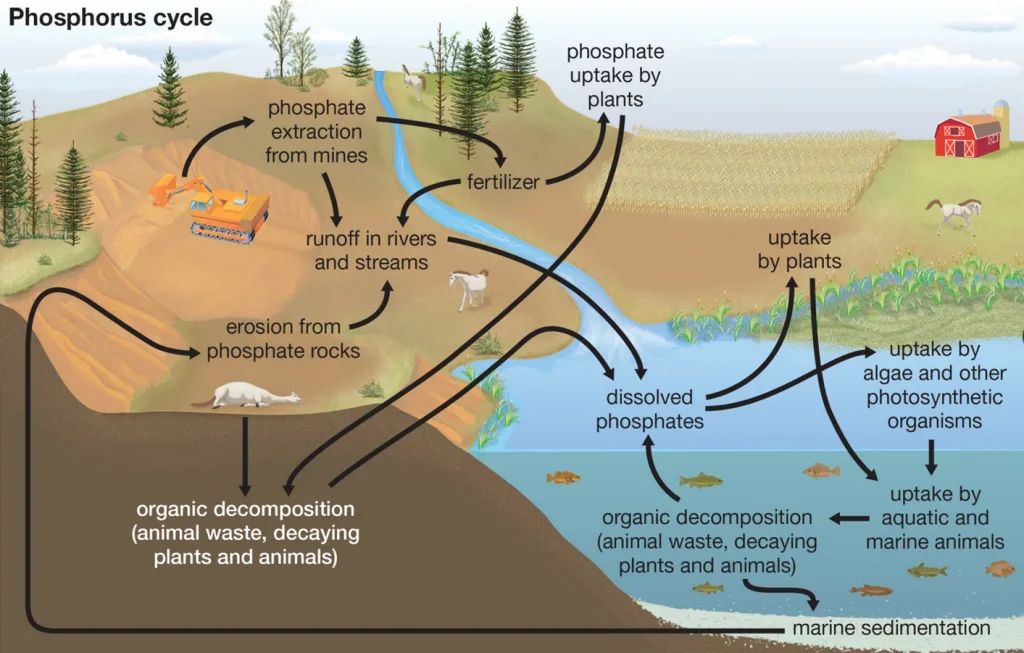Eutrophication is the process of excessive nutrient accumulation in water bodies, leading to the overgrowth of simple plant life like algae and plankton. This phenomenon deteriorates water quality and reduces oxygen levels, creating “dead zones” unsuitable for supporting life. Eutrophication occurs due to the gradual increase in phosphorus, nitrogen, and other nutrients in aging aquatic ecosystems, primarily from runoff carrying organic materials from land. This leads to water blooms, hindering light penetration and oxygen absorption necessary for underwater life. Consequently, eutrophic waters become murky and support fewer large animals compared to non-eutrophic waters.
Definition of Eutrophication
Eutrophication describe a process in which nutrients accumulate in a body of water which results in an increased growth of microorganisms that may deplete the water of oxygen.
Eutrophication, both natural and human-induced, enriches lakes with nutrients, promoting algae and macrophyte growth. Human activities, such as agriculture, exacerbate this process, impacting water quality and ecosystems. Eutrophication is now recognized as a significant anthropogenic effect, alongside deforestation and global warming, with profound consequences for natural environments.
Types of Eutrophication
Cultural Eutrophication
Cultural eutrophication accelerates the aging of water bodies through human pollution, including sewage, detergents, and fertilizers. This process profoundly impacts freshwater resources, fisheries, and recreational areas, leading to significant aquatic ecosystem degradation. In culturally eutrophic systems, hypoxia, or low oxygen levels in bottom waters, is common, especially in stratified lakes during summer when oxygen concentrations drop below critical levels. Water blooms worsen oxygen depletion, posing threats to wildlife. Hypoxic conditions from cultural eutrophication have caused massive fish kills in places like the Black Sea, disrupting food chains and local economies.
Coastal Eutrophication
Coastal marine systems are also vulnerable to eutrophication. Globally, rivers now discharge twice the amount of organic matter into oceans compared to prehuman times. Nitrogen and phosphorus fluxes have more than doubled, leading to cultural eutrophication in many marine ecosystems. This excessive loading of nutrients has affected various areas, including polluted eastern U.S. estuaries like Chesapeake and Delaware bays, the Gulf of Mexico near the Mississippi River, and estuaries in western Europe like the Scheldt of Belgium and the Netherlands.
Agricultural Eutrophication
Agricultural activities are major contributors to phosphorus in streams and lakes, primarily through soil erosion and fertilizer runoff. Nitrogen pollution from municipal sewage treatment plants and animal feedlots exacerbates the issue. Implementing pollution control measures and adopting better practices in agriculture, industry, and municipal waste management are essential for mitigating cultural eutrophication in both inland and coastal waters.
Causes of Eutrophication
The availability of nutrients, particularly nitrogen and phosphorus, plays a crucial role in regulating plant growth within aquatic ecosystems. Typically, these nutrients are present in limited quantities, acting as natural constraints on the proliferation of plant life. However, when water bodies become excessively enriched with nitrogen and phosphorus, a phenomenon known as eutrophication occurs.
In such conditions, the balance shifts, favoring the rapid growth of algae, plankton, and other simple plant organisms. These microorganisms thrive in the presence of abundant nutrients, forming dense blooms that can cover large expanses of water surfaces. As these blooms proliferate, they outcompete more complex plant species, such as submerged aquatic vegetation, which require clearer water and lower nutrient levels to flourish.
The dominance of algae and plankton alters the ecological dynamics of the aquatic environment. These organisms may produce toxins, release organic matter, and consume dissolved oxygen during decomposition, leading to significant changes in water quality and ecosystem health. Additionally, the dense growth of algae and plankton can block sunlight from reaching deeper water layers, inhibiting photosynthesis and further reducing oxygen levels.
Ultimately, the excessive growth of algae and plankton disrupts the delicate balance of aquatic ecosystems, posing threats to biodiversity, water quality, and the overall ecological integrity of water bodies. Addressing the inputs of nitrogen and phosphorus through effective management practices is essential for mitigating the impacts of eutrophication and restoring the health and resilience of aquatic ecosystems.
How do Water Bodies Become Overly Enriched?
Phosphorus is widely recognized as a primary limiting factor for plant growth in freshwater ecosystems, while nitrogen is also crucial for algae growth. Phosphates, a form of phosphorus, adhere to soil particles and are carried into water bodies through soil erosion, making it a significant contributor to phosphorus enrichment. Other sources of phosphorus enrichment in water bodies include:
- Fertilizers
- Detergents containing phosphorus
- Untreated sewage
- Industrial discharge of waste.
Among these sources, agricultural runoff and industrial waste are among the primary contributors to eutrophication.
What Happens to the Huge Biomass of Algae in Eutrophic Waters?
The excessive growth of algae in eutrophic waters leads to the generation of a significant biomass of dead algae, which sinks to the bottom of the water body. Bacteria then break down this biomass through decomposition, consuming oxygen in the process. Consequently, the oxygen levels in the water decrease, creating hypoxic conditions, particularly in the deeper layers. This oxygen depletion poses a severe threat to aquatic life, especially larger organisms such as fish, which rely on oxygen to survive. As hypoxia progresses, it leads to the suffocation and eventual death of these organisms, further exacerbating the ecological impact of eutrophication on aquatic ecosystems.
Classification of Eutrophication
The process of eutrophication can be categorized into two types based on its root cause, each with distinct mechanisms driving the enrichment of nutrients in aquatic ecosystems. The first type, natural eutrophication, occurs as a part of the natural aging process of water bodies. Over time, lakes and other water systems accumulate nutrients such as nitrogen and phosphorus from various sources, including organic matter decomposition and sediment runoff. As these nutrients build up, they promote the growth of algae and other aquatic plants, gradually altering the ecosystem’s balance.
Anthropogenic Eutrophication
Anthropogenic eutrophication, a product of human activities, manifests through various pathways, each uniquely impacting aquatic ecosystems. One prominent contributor is the widespread use of fertilizers in agricultural practices, on golf courses, and in urban landscaping. Following rainfall, these fertilizers are washed into nearby water bodies, enriching them with nutrients and kickstarting the growth of algae and plankton, thus setting the stage for eutrophication.
The pressures of population growth and urbanization further exacerbate eutrophication. With expanding industrial and agricultural sectors often comes deforestation, which intensifies soil erosion. As a result, water bodies receive higher sediment loads, particularly rich in phosphorus. This influx of phosphorus accelerates eutrophication, disrupting the natural balance of aquatic ecosystems and threatening their health and sustainability.
In addition to soil erosion, the direct discharge of sewage and industrial waste into water bodies exacerbates eutrophication. These waste streams carry significant quantities of nutrients, which further stimulate algal and planktonic growth. This influx of nutrients speeds up the eutrophication process, causing profound ecological disruptions and jeopardizing the integrity of aquatic habitats.
Addressing anthropogenic eutrophication requires comprehensive strategies that target its various sources. Efforts to minimize fertilizer runoff, promote sustainable land management practices, and improve wastewater treatment are crucial steps in mitigating the impacts of eutrophication and preserving the health of aquatic ecosystems for future generations.
Natural Eutrophication
Natural eutrophication denotes the enrichment of water bodies through natural occurrences. For instance, during floods, nutrients from the land can be carried into lakes or rivers, leading to an excessive nutrient influx. Consequently, these water bodies become overly enriched, fostering the rapid growth of algae and other simple plant life forms.
Compared to anthropogenic eutrophication, natural eutrophication progresses at a slower pace. Additionally, its progression may be influenced by environmental factors such as temperature. Furthermore, the effects of natural eutrophication may be exacerbated by temperature changes induced by global warming, further accelerating the enrichment of water bodies with nutrients.
Despite its slower pace, natural eutrophication can have significant ecological implications. Understanding the dynamics of natural eutrophication is crucial for assessing its impacts on aquatic ecosystems and implementing appropriate management strategies to mitigate its effects.
Effects of Eutrophication
Natural eutrophication, stemming from environmental processes, contributes to the enrichment of water bodies with nutrients, altering their ecological balance over time. This phenomenon progresses at a relatively slower rate compared to anthropogenic eutrophication, yet its impacts are significant and multifaceted. Some of the key effects of natural eutrophication include:
- Accelerated growth of phytoplankton species, particularly those that are toxic and inedible, leading to phytoplankton blooms.
- Rapid proliferation of gelatinous zooplankton in eutrophic waters, further disrupting the ecosystem’s balance.
- Significant shifts in the species composition and biomass of macrophytes, impacting the overall biodiversity of the ecosystem.
- Increased biomass of epiphytic and benthic algae, altering the composition and structure of aquatic flora.
- Reduction in water transparency, accompanied by unpleasant odors and discoloration, posing challenges for water treatment processes.
- Occurrence of frequent fish kill incidents, leading to the decline of desirable fish species and shellfish populations.
- Depletion of dissolved oxygen levels in the water column, endangering the survival of aquatic organisms’ dependent on oxygen.
- Diminished populations of harvestable fish, impacting the livelihoods of communities reliant on fishing activities.
- Decline in the aesthetic value of the water body, affecting its recreational and scenic appeal.
Understanding the myriad effects of natural eutrophication is essential for implementing effective management strategies to mitigate its impacts and preserve the health and integrity of aquatic ecosystems. By addressing the underlying causes and implementing sustainable practices, we can strive to minimize the adverse effects of eutrophication and safeguard the ecological balance of water bodies for future generations.
Ecological Effects of Eutrophication
Natural standing waters exhibit a spectrum of nutrient levels, ranging from ultra oligotrophic to eutrophic, with a gradual increase in productivity and associated parameters. However, the process of eutrophication introduces significant changes, not only altering overall productivity but also impacting the vertical structure of lakes. These changes have far-reaching implications for the biology and ecology of freshwater organisms.
The transition from eutrophic to hypertrophic status, characterized by excessive nutrient enrichment, is often attributed to human activities. Anthropogenic inputs such as agricultural runoff, sewage discharge, and industrial pollution contribute to this transition, disrupting the natural balance of freshwater ecosystems. This shift has profound effects on water quality, biodiversity, and ecosystem functioning, ultimately jeopardizing the ecological equilibrium of the entire freshwater system.
Addressing eutrophication requires concerted efforts to mitigate human-induced nutrient inputs and restore the ecological integrity of freshwater environments. Implementing sustainable land management practices, improving wastewater treatment methods, and enhancing regulatory measures are essential steps in reversing the detrimental impacts of eutrophication and preserving the health of natural standing waters for future generations.
Increase in Water Toxicity
Certain algae species possess toxins that are harmful to both plants and animals. When these algae undergo blooms in eutrophic waters, they release neurotoxins and hepatotoxins into the surrounding environment. These toxins can permeate the food chain through shellfish and other marine organisms, resulting in widespread mortality among various species.
Toxic algal blooms not only impact marine life but also pose significant risks to human health. Consumption of contaminated shellfish can lead to various forms of shellfish poisoning, including neurotoxic, paralytic, and diarrhoetic shellfish poisoning. These illnesses can cause severe neurological symptoms, paralysis, and gastrointestinal distress, posing a serious threat to public health.
Decrease in Biodiversity
When an aquatic ecosystem receives an influx of nutrients, whether from natural processes or human activities, it creates highly favorable conditions for primary producers. Typically, algae and similar organisms capitalize on these nutrients, leading to a significant population surge known as an algal bloom.
These algal blooms pose several challenges to the aquatic environment. Firstly, they obstruct the penetration of sunlight to the deeper layers of the water body, disrupting photosynthesis and affecting the growth of submerged vegetation. Additionally, algal blooms cause fluctuations in dissolved oxygen levels within the water column.
As the algal biomass increases, the demand for oxygen during decomposition processes also rises. Consequently, dissolved oxygen levels can plummet to hypoxic levels, where concentrations are insufficient to support marine life. This oxygen depletion leads to suffocation and mortality among aquatic organisms, resulting in a decline in biodiversity within the water body.
Invasion of New Species
The process of eutrophication can lead to a significant alteration in the species composition of aquatic ecosystems and the surrounding environment by increasing the availability of limiting nutrients. For instance, if a water body is deficient in nitrogen, eutrophication can result in an abundance of nitrogen, attracting new species to the ecosystem. This influx of competitive species may out-compete the original inhabitants, reshaping the ecosystem dynamics. An illustrative example of this phenomenon is the introduction of the common carp, which thrives in eutrophic conditions.
Eutrophication is a pervasive water quality issue, affecting freshwater bodies across the globe, irrespective of geographical location or economic development status. It is prevalent in rivers and streams worldwide, often exacerbated by sewage treatment discharges, which introduce additional nutrients into freshwater ecosystems, impacting fisheries ecology. Despite its widespread occurrence, eutrophication remains a significant challenge for both developed and developing countries, underscoring the urgent need for comprehensive management strategies to mitigate its impacts and preserve the health of freshwater ecosystems.
Conclusion
In conclusion, eutrophication stands as a pervasive and significant challenge to the health and integrity of freshwater ecosystems worldwide. Whether triggered by natural processes or human activities, the enrichment of water bodies with nutrients leads to a cascade of ecological impacts, from algal blooms to oxygen depletion and shifts in species composition. The consequences of eutrophication extend beyond the aquatic environment, affecting biodiversity, water quality, and human health.
Addressing the complex issue of eutrophication requires concerted efforts at local, regional, and global levels. Sustainable land management practices, improved wastewater treatment technologies, and effective regulatory measures are essential components of comprehensive eutrophication management strategies. Furthermore, public awareness and engagement are vital in fostering a deeper understanding of the causes and impacts of eutrophication and mobilizing collective action towards its mitigation.
By prioritizing the preservation and restoration of freshwater ecosystems, we can safeguard vital natural resources and ensure their sustainable use for future generations. Through collaboration, innovation, and commitment, we can effectively tackle the challenges posed by eutrophication and pave the way towards a healthier, more resilient aquatic environment.
Read Also:
- Indus River
- Advantages and Disadvantages of Artificial Intelligence [AI]
- 10 Tips to Lighten Your Hair Naturally
📍 SEO & Content Strategist | Expert in Current Affairs, History, Geography & Education Blogs | Digital Marketing Specialist
Muhammad Talha Mehmood is a seasoned digital marketing specialist, SEO expert, and content strategist with over six years of experience in creating high-impact, research-driven content. As the driving force behind Globaleak.com, he delivers in-depth articles on current affairs, history, geography, and education, helping readers stay informed with accurate, well-researched insights.
🔹 Expertise & Achievements:
✔ SEO & Content Strategy: Specializes in creating authoritative, high-ranking content that aligns with Google’s EEAT guidelines.
✔ Research & Analysis: Covers historical events, geopolitical trends, and educational topics with in-depth research and expert insights.
✔ Proven Track Record: Has successfully worked with global clients, delivering content that enhances brand trust, audience engagement, and search rankings.
✔ Academic Excellence: Holds an MBA in Marketing from IBA, University of the Punjab, and a B.Com (Hons) from Hailey College of Commerce.
✔ Industry Experience: Started his career with Packages Limited, trained under PITB’s E-Rozgar Program, and later became a Team Leader & Trainer at Emenac Group of Companies.
🚀 Passionate about creating impactful content, Muhammad Talha ensures every article is insightful, engaging, and value-driven.
📧 Email: talhamehmood34@gmail.com
🔗 LinkedIn: linkedin.com/in/talhamehmood-34










